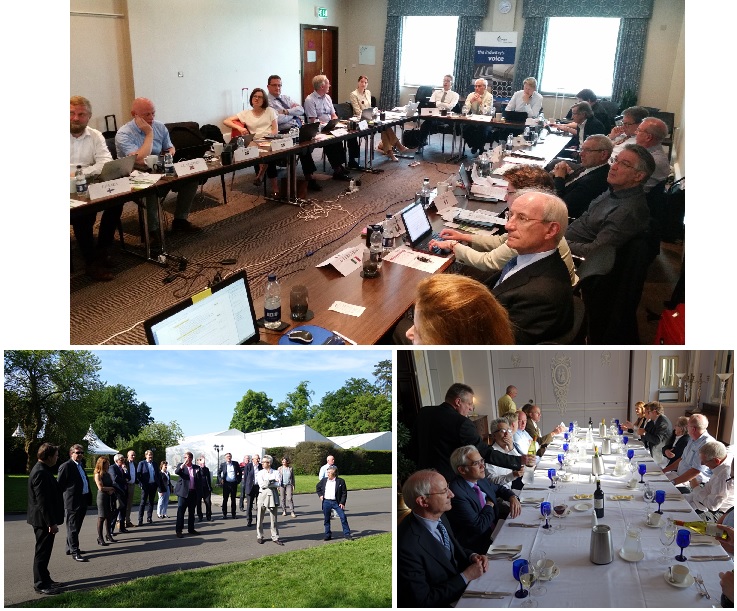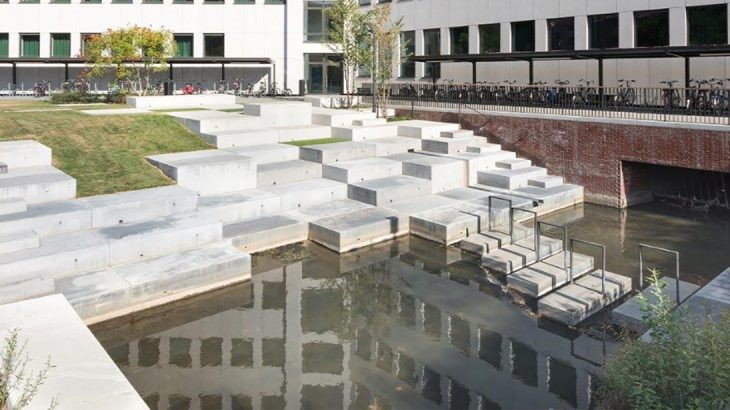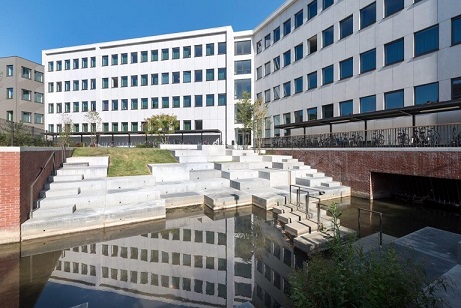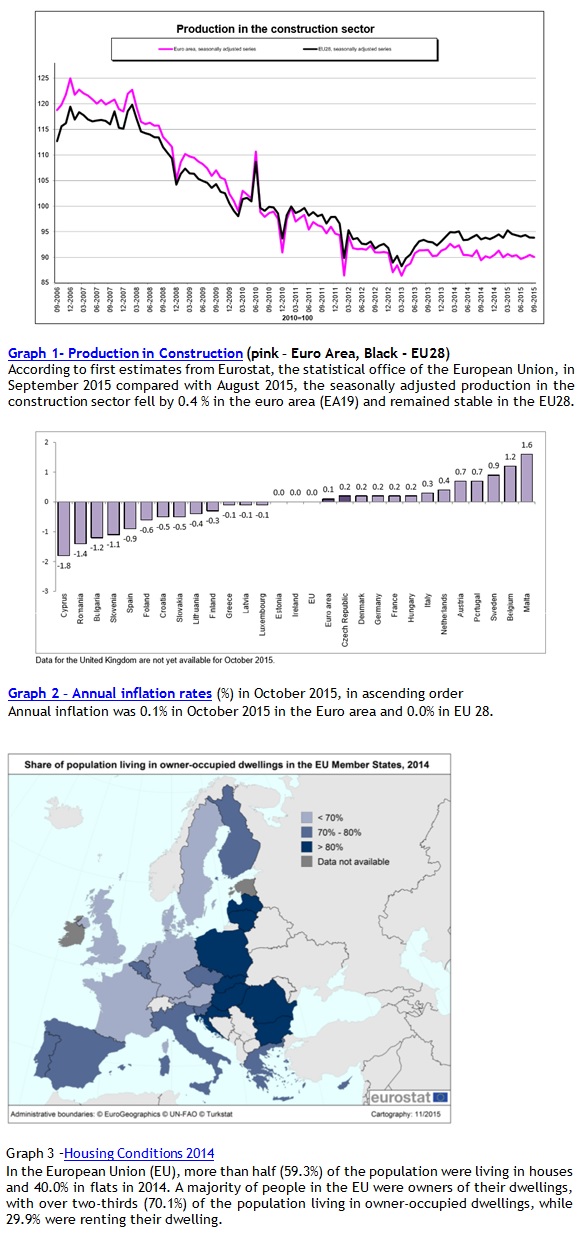Concrete Perspectives November 2015
Internal News
BIBM General Assembly

On 17 November, the BIBM General Assembly took place in Brussels. At the meeting, the ongoing Strategic Plan was discussed and updated. Two topics were discussed more in depth with the participation of external experts:
- The possible inclusion of respirable crystalline silica into the “Carcinogen and Mutagen at workplace” directive, with the intervention of Michelle Wyart-Rémy, co-chair of the NEPSI council
- The upcoming revision of the energy performance of buildings directive, with the participation of Linn Johnson (European Commission – DG Energy)
The General Assembly gave farewell to Mr Marc Lebrun, CEO of CERIB and the Fédération Industrie du Béton and to Mr Bernd Wolschner former BIBM President and current President of VÖB. The General Assembly also welcomed a new Board member, Mr Arnaud Schwartzentruber who is the Director of R&D, Quality & Safety of the Group Rector Lesage.
The Concrete Initiative – Roundtable Debate
On 19 November 2015, The Concrete Initiative held its annual event, Concrete Dialogue 2015, entitled: Citizens at the heart of the sustainably-built environment. This event brought together Members of the European Parliament, European Commission and civil society for a concrete dialogue roundtable to debate issues of relevance to sustainable construction.
The Press Release, the Programme, the presentations and pictures are now all available on the webpage of the event.

Construction Sector
- The University of Dundee will hold next year (4-6 July 2016) the 9th International Concrete Conference with the theme “Environment, Efficiency and Economic Challenges for Concrete”. There is an open call for papers for several thematic areas.For further information please visit: http://www.ctucongress.co.uk/.
- On 6 November 2016, the European Demolition Association (EDA) released the European Demolition Industry Report 2015 (only some pages are available for free) on the World Demolition Summit in Amsterdam, The Netherlands. The report offers a country overview about the market situation (construction and demolition) and special report on demolition industry in EDA countries.
The industry report represents a major attempt to have solid data with standardized methodology about the demolition market.
- On 30 October 2015, on World Cities Day, in his speech, the United Nations Secretary-General Ban Ki-moon underlined the essential role of urban design in building sustainable, socially integrated and prosperous cities.
He added that the UN Conference on Housing and Sustainable Urban Development (Habitat III), to be held in Quito, Ecuador in October 2016, will be an opportunity to discuss a New Urban Agenda.
- On 4 November 2015, the European Commission DG GROW published an analysis of the implementation of Construction Products Regulation (305/2011/EU).
- On 6 November 2015, the Architects’ Council of Europe (ACE), the International Union of Architects (UIA), the National Council of the Order of French Architects (CNOA), and the International Council of French Architects (CIAF) published the “Manifesto for Responsible Architecture – Architects Commitments to the Climate of the future” which presents the architects’ commitment to tackle the challenges.
- On 19 November 2015, DG Environment publication “Science for Environment Policy” published an article on a study entitled “Carbon footprint comparison of innovative techniques in the construction and maintenance of road infrastructure in The Netherlands”.
The researchers assessed the potential benefits associated with 10 innovations in road construction and maintenance, and compared them to conventional materials and processes.
- On 23 November 2015, the International Energy Agency (IEA) published a report entitled “Building Energy Performance Metrics”. The report is co-written with the International Partnership for Energy Efficiency Cooperation (IPEEC) and it assesses the potential annual savings of buildings by the deployment of best available technologies and energy efficiency policies.
- On 24 November, the Copenhagen Economics (CE) published a press release about a recent comprehensive analysis of the Danish housing market. The study shows that homes with better energy efficiency ratings are sold at higher prices compared to similar houses with lower ratings. The study is based on extensive econometric studies, including 365,000 house sales observations as well as an innovative experimental approach using behavioural economic tools.
- The International Standard Organisation (ISO) Technical Committee on “Bases for design of structures” (ISO/TC98) published its strategic business plan on 20 November 2015.
- On 30 November, CEMBUREAU, the European Cement Association published its position on COP 21 (United Nations climate change conference). Amongst others, CEMBUREAU asks for “long term, stable and reliable environment to encourage investments”.
- BPIE (Building Performance Institute Europe) published a new report entitled “Renovation in practice- best practice examples of voluntary and mandatory initiatives across Europe”. The report analyses a variety of approaches and solutions to tackle the renovation challenge in terms of scale, financing, addressing non-technical barriers, level of ambition and achievement of social objectives.
European Commission publishes circular economy package
On 2 December, the European Commission published the long-awaited circular economy package. The publication comes after the European Commission withdrew the waste directives last year.
The new package, which consists of an action plan and a new waste directive, contains long-term measures to increase recycling and reuse of construction waste, and it lowers the EU 2020 targets in general (for municipal and packaging waste), however for construction and demolition waste the goal remains 70% target for all material recovery operations by 2020.
First Vice-President Timmermans emphasized that even though some targets are lowered, the present package is more ambitious than the old one, because it covers the full circle and not only wastes. Additionally, it contains concrete measures describing how to achieve the targets in a realistic way. Targets were set after examining the current status of different national situations.
The package also asks member states to “take measures to promote sorting systems for construction and demolition waste and for at least the following: wood, aggregates, metal, glass and plaster”.
During the press conference of the presentation of the package, Vice-President Katainen confirmed that the paper recognises the importance of creating markets for secondary raw materials, and integrating durability, reparability and recycling of products in Eco-design (the study on the Eco-design Work Plan 2015-2017 is expected to be finished in January 2016).
The new waste directive defines the definition of backfilling as “any recovery operation where suitable waste is used for reclamation purposes in excavated areas or for engineering purposes in landscaping or construction instead of other non-waste materials which would otherwise have been used for that purpose”.
The action plan states that the Commission is currently conducting a study which aims at collecting best practices and identifying obstacles and drivers for construction and demolition waste recycling.
As for the financing, the package states that €650 million under Horizon 2020 and €5.5 billion under the structural funds are available for funding.
While the re-tabled waste directive will be legally binding, the action plan is not mandatory; however it indicates the future policy recommendation to be followed.
According to the ordinary legislative procedure; the new waste directive will be now transferred to the European Parliament and to the Council of the EU.
Please find here BIBM’s position paper on the new circular economy package.
EU Energy related legislations under scrutiny
One step of these measures is the evaluation of the Energy Performance of Building Directive (EPBD 2010/31). The European Concrete Platform answered the public consultation (30/06-31/10) and underlined two main points:
- The contribution of thermal mass to energy efficiency is currently not sufficiently accounted for. Thermal mass also improves well-being and comfort, both in hot and cold climate.
- The methodologies for calculating the energy performance of buildings is variable among Member States, even though there are standards developed by ISO / CEN to provide a standard methodology (such as ISO-EN 13790 – being revised and will be called EN ISO 52016-1). Measures should be taken to use the appropriate method and modelling when calculating the energy performance of buildings.
The European Commission is in charge of monitoring the implementation of the Directive in the Member States and it recently decided to refer Greece to European Court of Justice for not having calculated the cost-optimal levels of minimum energy performance requirements for buildings.
The European Commission also looks into additional areas to be explored, such as affordable housing, smartness of the building, heating and cooling networks and maintenance.
On 4 November 2015, the European Commission published the inception impact assessment on the review of the Energy Performance of Buildings Directive, including the ‘Smart Financing for Smart Buildings’ initiative. The main objectives of the initiative are to improve access to funding and stimulate investments; and to address the shortcomings identified by the evaluation of the EPBD.
The outcome of the public consultation and the end of the ongoing evaluation will be probably available early next year (February 2016).
Apart from the evaluation of the EPBD, the Eco-Design directive will be also under revision in 2016. The Eco-design Working Plan 2015-2017 will be soon to be adopted by the European Commission. The new Working Plan will focus on developing product requirements under the Eco-design directive.
While the current Eco-design directive focuses only on energy efficiency, the revision of the directive will probably broaden the scope and include resource efficiency issues such as reparability, durability, and recyclability will be examined.
The revision of the Energy Efficiency Directive (2012/27/EU) is also expected in the course of next year. “The Commission foresees legislative proposals to align the Energy Efficiency Directive to the 2030 indicative EU-level target of at least 27% (to be reviewed by 2020, having in mind an EU level of 30%)”[1].
State of Union Energy Package
The European Commission adopted the State of Union Package on 18 November 2015. The following initiatives are planned for 2016 related to sustainable construction:
- A dedicated strategy for heating and cooling is planned for early 2016, aiming for a smart transformation of this sector.
- Commission will establish schemes to aggregate smaller energy efficiency projects. These schemes aims at providing investors with better investment opportunities in energy efficiency and make capital better accessible for national, regional or local energy efficiency platforms and programmes.
Commissioner Vella: Construction essential for circular economy
Following the Roundtable debate organised by The Concrete Initiative, a EurActiv[2] special report was devoted to the issue of circular economy from the sustainable construction perspective.
Commissioner Vella, who opened The Concrete Initiative event in a video message, said that construction would be an essential part of the transition to a circular economy and it is essential to create jobs and growth.
While talking about sustainable construction, he said “Sustainability consists of three pillars, and they all need to go hand in hand. At the moment, we are focusing on the environmental performance of buildings, while keeping the social and economic aspects in mind.”
The European Commission launched several initiatives to better exploit the potential of the construction sector and buildings.
The full article can be found on the website of EurActiv, and several other articles related to the special report on sustainable construction.
You can also read the article entitled “Circular Economy package to regulate construction sector” in which the concrete and cement industry describes its contribution to the circular economy.
An infographic about “The best ways to destroy your house” was also published in the framework of the above mentioned special report.
[1] State of Energy Union http://ec.europa.eu/priorities/energy-union/state-energy-union/docs/communication-state-energy-union_en.pdf
[2] EurActiv, the leading online media on EU affairs, is a European Media Network present in 12 EU capitals.
Belgium – Small Scale Precast Award 2015 pour Hydro Lineo
Hydo Lineo is a concept of three different concrete paving stones, having a size of 30x10cm. The first model is fully closed, while the second has 22% and the third has 40% opening. These holes can be filled with grass, herbs or gravel. The three different models can be used independently, or interchangeably. They can be laid in either rows, patterns or randomly.
Precaster : Stradus Infra


News in brief

Agenda
DECEMBER
1st December 2015
Ceramic days
Brussels, Belgium
3 December 2015
The Concrete Initiative Thematic Lunch on Rebuilding (upon invitation only)
Brussels, Belgium
10 December 2015
CPE Workshop on EPDs
Brussels, Belgium
17 December 2015
EMA meeting
Brussels, Belgium
JANUARY
15 January 2016
CPE TG CPR implementation
Brussels, Belgium
19 January 2016
BIBM Board meeting
Brussels, Belgium
21 January 2016
ECP TF Sustainable Concrete
Confcall
26 or 27 January 2016 (tbc)
CPE event in the European Parliament
Brussels, Belgium
To the Newsletter of Construction Products Europe (former CEPMC), please follow this link.
To read the Newsletter of CEMBUREAU, please follow this link. You can also subscribe directly following this link http://www.cembureau.eu/newsletter/subscriptions.
To read the Quarterly Newsletter of The Concrete Initiative, please follow this link.
List of Acronyms
CPE – Construction Product Europe
CPR – Construction Products Regulation
C&D waste – construction and demolition waste
ECP – European Concrete Platform
EMA – European Masonry Alliance
JRC – Joint Research Centre of the European Commission
PCR – Product Category Rules
TF – Task Force
AhG – Ad-hoc Group
